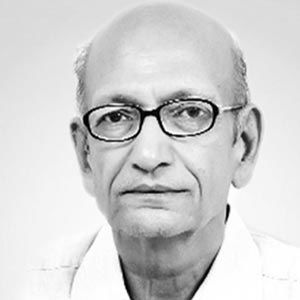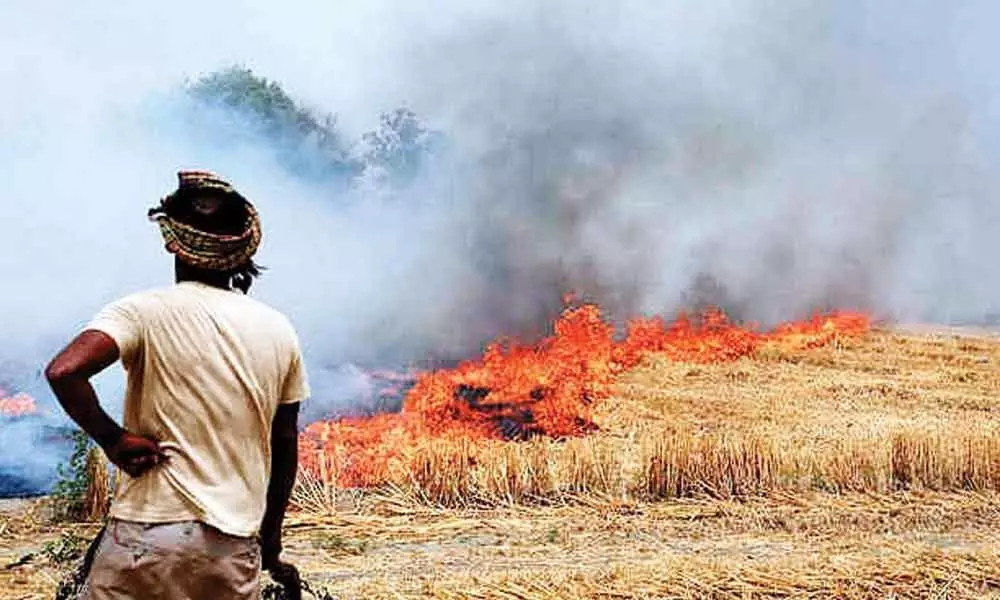Live
- DEO suspends teacher accused of sexual assault
- PM ‘cursing’ Congress out of despair: Maharashtra Cong Chief
- Applications are invited for Junior Colleges Scheme District Scheduled Castes Development Officer Ramlal
- A nomination was filed on the second day for the Nagar Kurnool parliamentary seat
- SP Gaikwad inspected the Telangana Amarnath Saleswaram Jatara yatra arrangements
- Rahul Gandhi's decision to contest from Wayanad shows 'lack of confidence': BJP President Nadda
- IPL 2024: Delhi bowlers will go after all of SRH’s top-order batters, says head coach Ricky Ponting
- At Amroha rally, PM Modi sends out ‘meaningful’ message for Muslims and Hindus
- Tripura records highest 79.83 pc voter turnout in Northeast
- The government has to clear the confusion
Just In
Stubble burning not culprit of air pollution


The Supreme Court has ordered that the farmers should be paid Rs 100 per quintal or Rs 1 per kilogram to incentivise them not to burn the stubble.
The Supreme Court has ordered that the farmers should be paid Rs 100 per quintal or Rs 1 per kilogram to incentivise them not to burn the stubble.
This is a welcome step. Stubble burning has certainly added to the air pollution in Delhi in the past many days. Yet, this is not the core problem.
Delhi and Kolkata figure among the ten most polluted cities in the world. Now, Kolkata does not face the problem of stubble burning. The air quality of Delhi is not much better in non-stubble burning period either. Therefore, the problem runs deeper.
The four permanent causes for air pollution are traffic, thermal power plants, heavy industries and solid waste incinerators. The solutions to traffic-based pollution are many.
London was suffering from this malaise. The city made tough emission standards for the vehicles and, according to one report, imposed a "hefty daily fee on cars which emit more than 75g/km of carbon dioxide." This led to lesser numbers of high-emission vehicles on the streets.
The city has also earned £55 million to invest in its transportation network. The first solution, therefore, is to implement stricter emission standards. It is also necessary to reduce the use of private cars. This requires more investment in public transport. The Metro has done wonders.
The bus network needs to be expanded and made efficient as well. Other innovative measures need to be thought off. For example, highways in the United States have special "High Occupancy Vehicle" lanes that are much less congested.
Only cars carrying minimum of three passengers are allowed to ply on these lanes. It can be similarly provided that cars carrying minimum of three passengers alone will be allowed to ply on the streets of Delhi.
The second source of air pollution is the large numbers of thermal plants located around Delhi. The government has recently diluted the air pollution norms for thermal plants thus adding to pollution.
These must be made stricter. Further, there is a need to reconsider the thermal power-based approach being followed today. The four major sources of electricity are coal-based thermal, hydropower, nuclear and solar.
Thermal power is clearly "dirty." It not only pollutes our air, but it also adds substantially to global warming which is threatening the very existence of the human civilisation. Hydropower is dirtier.
The organic matter such as leaves and animal carcasses that flow into the reservoirs settle at the bottom and begin to ferment. The oxygen in the water at the bottom of the reservoir is soon used up.
Then the fermentation process starts releasing methane which is twenty times more harmful than carbon dioxide.
In comparison, nuclear power is environmentally benign if the plants are established away from habited areas and are based on zero water discharge. Solar power is also environment friendly.
The need is to close all thermal and hydro plants and move to solar and nuclear.
The third source of air pollution is heavy industries. The government is pushing "Make in India" and wanting to invite multinational corporations to establish large manufacturing industries in India.
These industries have the distinction of making three of China's cities —Chengdu, Shenyang and Wuhan — among the world's ten most polluted cities. We have only three percent of the world's land but 18 percent of the population.
Thus, creating jobs for our burgeoning population in the manufacturing sector will lead to increased consumption of energy and increased pollution.
The need is to move from manufacturing to services sector which includes activities such as translations, software and music that consume about one-tenth of the energy required in manufacturing.
The fourth source of air pollution is solid waste incineration. The large amount of solid waste produced by our cities is mostly put in huge landfills. This waste contains organic matter like paper, wood and cotton cloth that can either be recycled or composted.
The other part is of inorganic matter such as plastic and metals. These can also be recycled. Plastic can also be used in road construction. Thus, we are wasting these precious natural resources twice.
First, we are losing these resources by putting them in a landfill instead of recycling them. Second, we are spending money in incinerating these materials and also causing air pollution.
The main problem is that it is expensive to sort the solid waste. At present the kabaris are doing a wonderful job of segregating and recycling part of the waste.
But they extract only the small more valuable solid waste and dump the larger less valuable part. The solution is to for the government to make tenders for buying sorted solid waste.
This will solve the problem of landfills and air pollution, and also create large numbers of eco-friendly jobs.
The fifth source of air pollution is stubble burning. This takes place once a year for about 10 days. The stubble is also a valuable natural resource. It is used for making paper.
It can also be used as fuel for generation of electricity or composted and used as manure. The main problem is that it is voluminous. The cost of baling and transportation is very high.
The price of paddy stubble on the gate of a paper factory is about Rs 5 to Rs 10 per kilo. However, farmers prefer to burn it because they cannot reach it to the paper factory at this price.
They also need to quickly clear the fields to sow the next winter crop. The Supreme Court has ordered the government to pay Rs 1 per kilo to the farmers as an incentive not to burn. This is too small to cover the cost of baling and stacking.
Moreover, the farmer simply does not have the labour available at this time when sowing is in full swing. Once again, the solution is for the government to make tenders for buying baled stubble and then auction the bales to the paper factories.
The contractors will bring labour from across the country and collect all the stubble just as traders go from village to village buying grains. This will not only solve the problem of air pollution but also conserve our natural biomass.
The sixth source of air pollution is lighting of crackers during Diwali. The solution is to invent and make green crackers.
At the end of the day, the question is of money. I am confident that the benefits from the control of air pollution are much more than the cost of all the steps enumerated above.
We can clean up the air in all out cities if the government is willing to pay.
The writer is formerly Professor of Economics at IIM Bengaluru

© 2024 Hyderabad Media House Limited/The Hans India. All rights reserved. Powered by hocalwire.com






